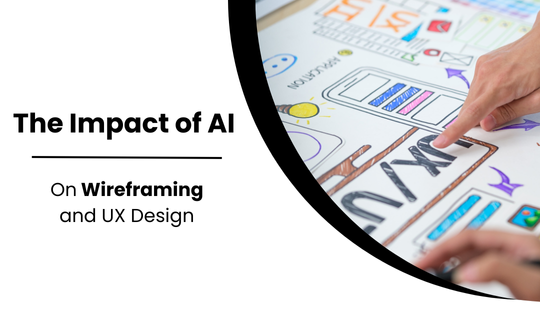
The Impact of AI on Wireframing and UX Design
In the ever-evolving digital landscape, the integration of artificial intelligence (AI) in wireframing and UX design is transforming the way designers work, enhancing efficiency, and improving user experiences. For Flykez CO, a creative brand company in France, leveraging AI in their website design, development, SEO, brand identity, digital marketing, and UI/UX design services can lead to significant advancements. This blog post explores the impact of AI on wireframing and UX design, offering insights into how these technologies can be harnessed for optimal results.
Revolutionizing Wireframing with AI
Wireframing is a critical step in the design process, serving as the blueprint for a website or application. Traditionally, creating wireframes has been a manual, time-consuming task. However, AI is revolutionizing this process by automating many aspects of wireframing, enabling designers to work more efficiently and effectively.
Enhanced Efficiency and Speed
AI-powered tools can significantly speed up the wireframing process by automating repetitive tasks and providing intelligent suggestions. For instance, AI can automatically generate wireframe layouts based on user requirements and design preferences, allowing designers to focus on refining and enhancing the design rather than starting from scratch.
Improved Accuracy and Consistency
AI ensures consistency and accuracy in wireframing by adhering to predefined design standards and guidelines. This reduces the likelihood of errors and inconsistencies, resulting in more polished and professional wireframes. AI tools can also analyze existing wireframes and suggest improvements, ensuring that the design aligns with best practices and user expectations.
Intelligent Predictions and Recommendations
AI can analyze vast amounts of data to predict user behavior and preferences, offering valuable insights that can inform the wireframing process. By understanding how users interact with similar websites or applications, AI can recommend design elements and layouts that are likely to resonate with the target audience.
Enhancing UX Design with AI
AI is also making significant strides in UX design, providing tools and technologies that enhance the overall user experience. From personalizing user interactions to optimizing design elements, AI is at the forefront of UX innovation. Also Read About Top Free Wireframe Tools for Designers on a Budget
Personalization and Customization
One of the most significant impacts of AI on UX design is its ability to deliver personalized user experiences. AI algorithms can analyze user data to understand individual preferences and behaviors, allowing designers to create customized interfaces that cater to each user’s unique needs. This level of personalization enhances user satisfaction and engagement.
Data-Driven Design Decisions
AI enables data-driven design decisions by providing insights into user behavior and preferences. By analyzing data from various sources, AI can identify patterns and trends that inform design choices. This helps designers create interfaces that are not only aesthetically pleasing but also highly functional and user-friendly.
Enhanced User Testing
AI-powered tools can automate and enhance user testing, providing real-time feedback and insights. For example, AI can simulate user interactions to identify potential usability issues and recommend improvements. This allows designers to iterate quickly and refine their designs based on real user data.
Streamlining Collaboration
AI facilitates better collaboration among design teams by providing tools that streamline communication and coordination. For instance, AI can automate the process of collecting and analyzing feedback from stakeholders, ensuring that everyone is on the same page and that design decisions are well-informed.
Real-World Applications of AI in Wireframing and UX Design
Several AI-powered tools are already making a significant impact on wireframing and UX design. For example, platforms like Sketch2Code and Uizard use AI to convert sketches into wireframes and prototypes, drastically reducing the time and effort required to create initial designs. Additionally, tools like Adobe XD and Figma are incorporating AI features to enhance design workflows and improve collaboration among team members.
Case Study: Flykez CO
For Flykez CO, integrating AI into their wireframing and UX design processes can lead to numerous benefits. By leveraging AI-powered tools, the company can streamline its design workflows, improve the accuracy and consistency of its wireframes, and create highly personalized user experiences. This not only enhances the quality of their digital products but also positions Flykez CO as a leader in innovative design solutions.
Conclusion
The integration of AI in wireframing and UX design is transforming the way designers work, enabling them to create more efficient, accurate, and personalized user experiences. For Flykez CO, embracing these technologies can lead to significant advancements in their website design, development, SEO, brand identity, digital marketing, and UI/UX design services. By harnessing the power of AI, Flykez CO can continue to deliver exceptional digital experiences that meet the evolving needs of their clients and users. For more information on our services and to see how we can enhance your digital presence, visit Flykez CO.
